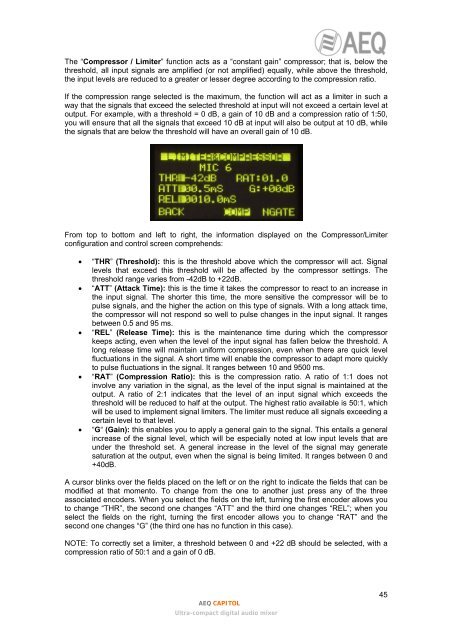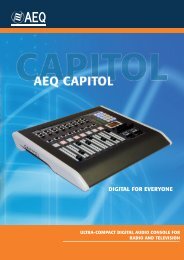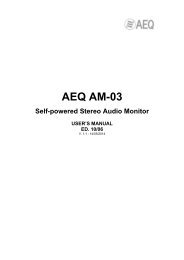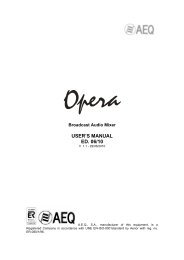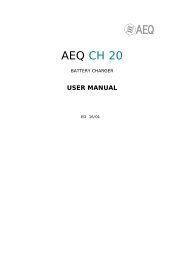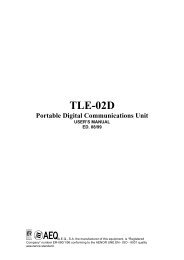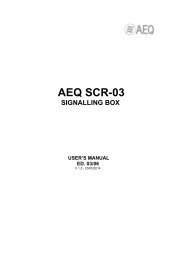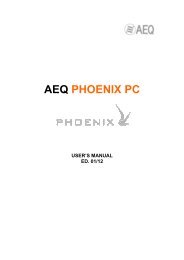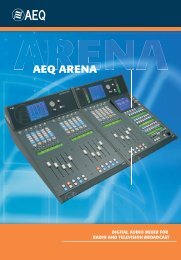Manual - AEQ International
Manual - AEQ International
Manual - AEQ International
You also want an ePaper? Increase the reach of your titles
YUMPU automatically turns print PDFs into web optimized ePapers that Google loves.
The “Compressor / Limiter” function acts as a “constant gain” compressor; that is, below thethreshold, all input signals are amplified (or not amplified) equally, while above the threshold,the input levels are reduced to a greater or lesser degree according to the compression ratio.If the compression range selected is the maximum, the function will act as a limiter in such away that the signals that exceed the selected threshold at input will not exceed a certain level atoutput. For example, with a threshold = 0 dB, a gain of 10 dB and a compression ratio of 1:50,you will ensure that all the signals that exceed 10 dB at input will also be output at 10 dB, whilethe signals that are below the threshold will have an overall gain of 10 dB.From top to bottom and left to right, the information displayed on the Compressor/Limiterconfiguration and control screen comprehends:• “THR” (Threshold): this is the threshold above which the compressor will act. Signallevels that exceed this threshold will be affected by the compressor settings. Thethreshold range varies from -42dB to +22dB.• “ATT” (Attack Time): this is the time it takes the compressor to react to an increase inthe input signal. The shorter this time, the more sensitive the compressor will be topulse signals, and the higher the action on this type of signals. With a long attack time,the compressor will not respond so well to pulse changes in the input signal. It rangesbetween 0.5 and 95 ms.• “REL” (Release Time): this is the maintenance time during which the compressorkeeps acting, even when the level of the input signal has fallen below the threshold. Along release time will maintain uniform compression, even when there are quick levelfluctuations in the signal. A short time will enable the compressor to adapt more quicklyto pulse fluctuations in the signal. It ranges between 10 and 9500 ms.• “RAT” (Compression Ratio): this is the compression ratio. A ratio of 1:1 does notinvolve any variation in the signal, as the level of the input signal is maintained at theoutput. A ratio of 2:1 indicates that the level of an input signal which exceeds thethreshold will be reduced to half at the output. The highest ratio available is 50:1, whichwill be used to implement signal limiters. The limiter must reduce all signals exceeding acertain level to that level.• “G“ (Gain): this enables you to apply a general gain to the signal. This entails a generalincrease of the signal level, which will be especially noted at low input levels that areunder the threshold set. A general increase in the level of the signal may generatesaturation at the output, even when the signal is being limited. It ranges between 0 and+40dB.A cursor blinks over the fields placed on the left or on the right to indicate the fields that can bemodified at that momento. To change from the one to another just press any of the threeassociated encoders. When you select the fields on the left, turning the first encoder allows youto change “THR”, the second one changes “ATT” and the third one changes “REL”; when youselect the fields on the right, turning the first encoder allows you to change “RAT” and thesecond one changes “G” (the third one has no function in this case).NOTE: To correctly set a limiter, a threshold between 0 and +22 dB should be selected, with acompression ratio of 50:1 and a gain of 0 dB.<strong>AEQ</strong> CAPITOLUltra-compact digital audio mixer45


